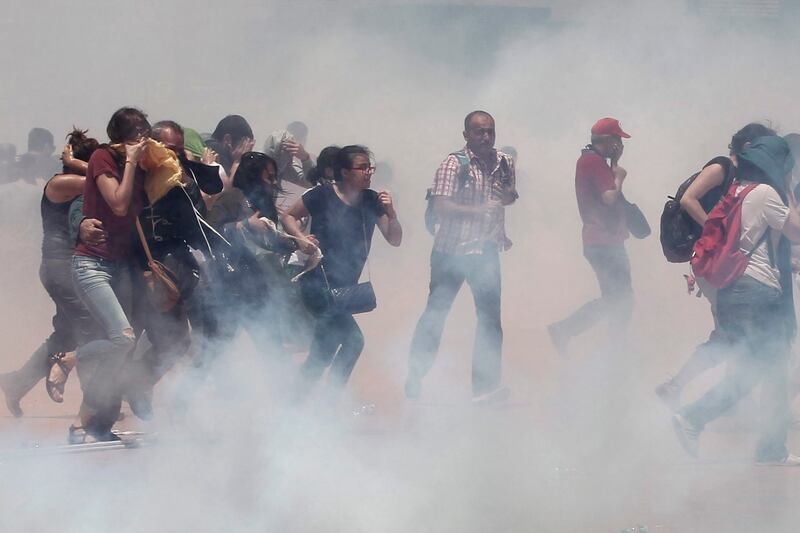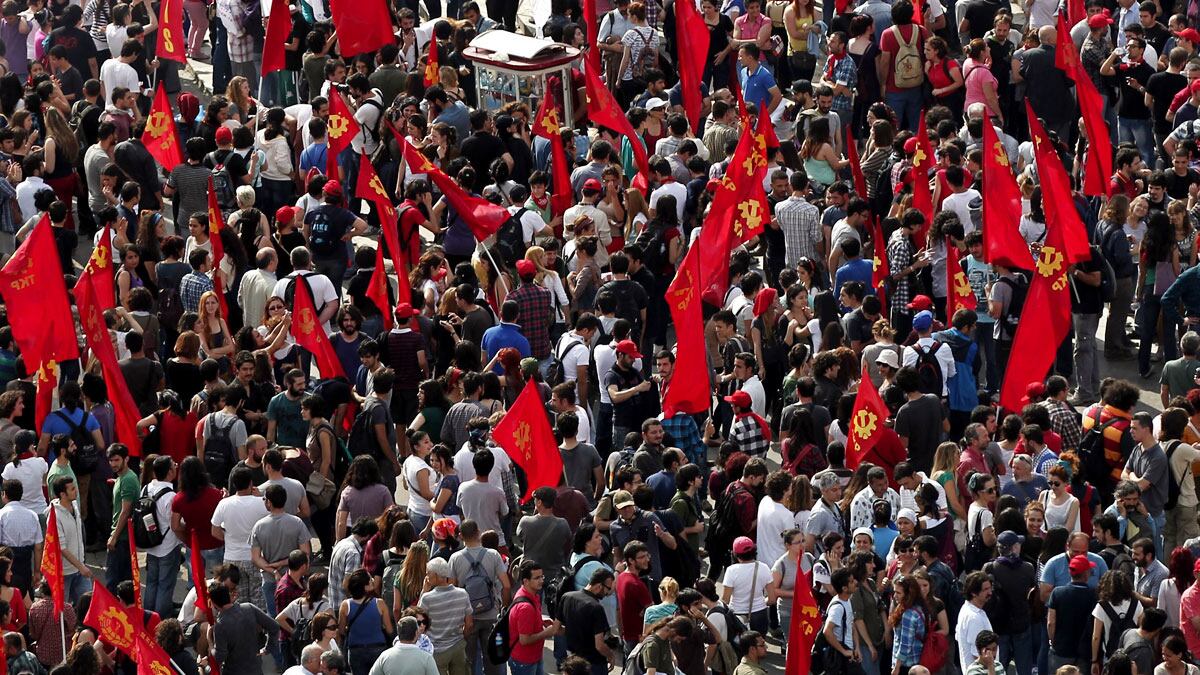The crowds in Taksim Square had free rein in the pre-dawn hours on Sunday. For days, Istanbul’s main square and the normally bustling pedestrian thoroughfare that spills into it had been the scene of clashes between police and protesters, with 1,000 people reportedly hospitalized. But the cops pulled back on Saturday, and the tear-gas clouds cleared. Thousands of jubilant protesters remained through the day, chanting against the government and shooting off fireworks.

The mood had darkened, though, as Saturday night wore on. Cars were vandalized and flipped on their sides. Protesters used some of the wrecked vehicles to build barriers in case police returned. Many were drinking; a shouting match broke out, sending onlookers scrambling to prevent a fight. In one corner of the square, a bus swayed as a crowd tried to topple it. Bystanders fled from another as a construction crane burst into flames. Minutes later, many headed for the exits, looking dismayed, as another construction vehicle exploded and gas fumes filled the air. “Because of these motherfuckers, we can’t celebrate our victory,” one man complained.
The protest movement that has gripped Istanbul over the last week started as a small push to save a tiny local park—and that singular and accessible cause has been its main strength. Turkey’s myriad political and activist groups frequently stage protests in Taksim, often facing an even heavier-handed response than the tear gas and water cannons that riot police turned on the park protesters in recent days. This time, instead of dispersing the crowd, the police response swelled its ranks exponentially.
To many Turks, the causes that usually bring protesters to the square tend to feel “small,” as one middle-aged schoolteacher put it earlier this week, standing near Taksim with tear gas still filling the streets. “But this one is about everybody.”
Taksim’s Gezi Park is just larger than a soccer pitch. But it’s one of the last green spaces in crowded central Istanbul, and when the bulldozers from one of the government’s latest and most controversial construction projects threatened to raze it to make room for a shopping mall, residents fought back. The project is the centerpiece of a plan to overhaul the area and turn traffic-choked streets into a pedestrian zone, but as with similar redevelopment projects across Istanbul, residents complain they have no say over their city’s fate—a microcosm of how many critics feel about the governing style of Prime Minister Recep Tayyip Erdogan.
As the park protest grew, regular Turks like the schoolteacher filled out its ranks, giving the movement rare staying power. By the weekend—as images like one of police spraying a pretty young woman in a red dress went viral—protesters shifted their target to Erdogan, accusing him of Islamism and authoritarianism. Similar demonstrations spread across the country.
But as protesters settled into their Taksim occupation—and the political groups that normally see their demonstrations thwarted filled the square with their slogans and flags—the new movement seemed to risk losing touch with its middle-of-the-road base. “We’ll stay here tonight. Tomorrow? I don’t know,” 17-year-old Berk Arslan said on Saturday night.
It was also unclear where the movement would go next. While many protesters stuck fast to the unlikely demand that Erdogan step down—even though he retains widespread popularity and cruised to victory in his last election—they dismissed the idea of someone from the notoriously ineffective opposition taking his place. “There’s nobody,” a man standing watch at a makeshift barrier said.
“I should do it,” added a woman nearby.
Opposition groups “have already tried to hijack the movement in many ways,” warns Kerem Oktem, a research fellow at the University of Oxford who writes on modern Turkey. The future of the protests, he adds, likely hinges on Erdogan’s response. “The benign scenario is the government and Erdogan realize that they have gone too far and change at least part of their ways,” he says. “Then there’s another scenario. This was a terrible humiliation for the government, and actually one quite unheard of in the history of Turkey. So it might well be that you get a very [harsh police] response, trying to take revenge for that. If that’s the case, then Erdogan has really lost the plot.”
In a series of interviews and televised speeches over the weekend, Erdogan struck a defiant tone. He said that the government’s park plans would continue; derided the protesters as extremists; called Twitter a “menace”; and suggested that he could bring far more people to the street. He also dismissed the protesters’ claims of authoritarianism. “If they call someone who has served the people a ‘dictator,’ I have nothing to say,” he said.

Soner Cagaptay, the director of the Washington Institute’s Turkish Research Program, says Erdogan is “a victim of [his] own success” in boosting Turkey’s economy since taking office in 2003. He and his Islamic-leaning Justice and Development Party (AKP) are widely credited with building up Turkey’s middle class, which now makes up the country’s majority, and for an explosion of development in Istanbul. But Erdogan has succeeded by governing with a controlling style that many Turks are growing to resent. “[They] take issue with the Turkish ruling party’s understanding of democracy,” Cagaptay says. “The middle class that the AKP has built is telling the governing party, ‘Democracy is not just winning elections, it is also building consensus. So do not push projects down our throats. Talk to us and listen.’”
By Sunday afternoon, protesters around Taksim had helped to clear away much of the debris from the previous days of chaos, and the festive mood prevailed as crowds returned. While ceding Taksim, though, police clashed violently with smaller bands of protesters elsewhere in Istanbul, and in cities such as Ankara, demonstrators continued to face a rough police response. No deaths have been reported, but one protester in Istanbul, 34-year old Lobna Allami, was in an induced coma, according to family and friends, after receiving a fractured skull in Taksim on Friday, likely from being struck by a tear-gas canister. “She’s fighting for her life,” her sister, Fatima Allami, told The Daily Beast.
Oktem, of Oxford University, says that in recent years Erdogan has indeed taken on a more heavy-handed tone, concentrating power in the prime minister’s seat as his party pushes through controversial laws. Many of these have been overtly religious—such as an education reform that oriented curriculums more toward religion, and controversial new restrictions on alcohol—riling critics who say the government is overstepping its bounds. “There are not many checks and balances left in the political system,” Oktem says. “That’s why people are on the street.”
Regardless of how the Taksim protests play out, Oktem adds, Erdogan must now contend with a broad swath of opponents who are newly politicized. “This is the first time they got a taste of politics. And they got a lot of gas as well. But I don’t think that they’re going to give up all that easily.”






